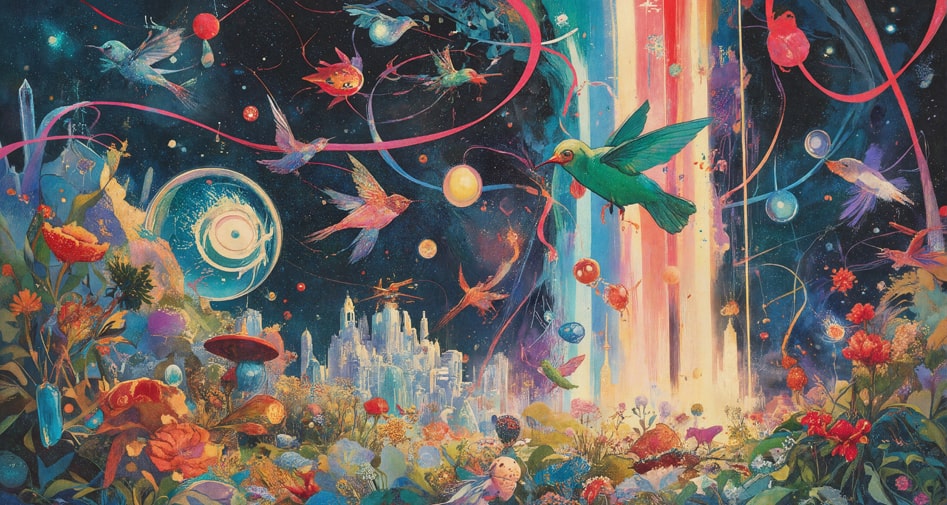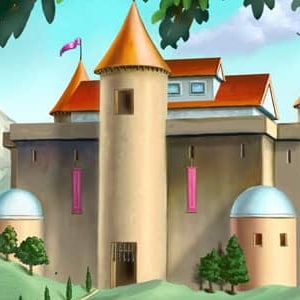Reading time for children: 17 min
There was once a poor countryman who used to sit in the chimney-corner all evening and poke the fire, while his wife sat at her spinning-wheel. And he used to say, „How dull it is without any children about us; our house is so quiet, and other people’s houses so noisy and merry!“ – „Yes,“ answered his wife, and sighed, „if we could only have one, and that one ever so little, no bigger than my thumb, how happy I should be! It would, indeed, be having our heart’s desire.“ Now, it happened that after a while the woman had a child who was perfect in all his limbs, but no bigger than a thumb. Then the parents said, „He is just what we wished for, and we will love him very much,“ and they named him according to his stature, „Tom Thumb.“ And though they gave him plenty of nourishment, he grew no bigger, but remained exactly the same size as when he was first born; and he had very good faculties, and was very quick and prudent, so that all he did prospered.
One day his father made ready to go into the forest to cut wood, and he said, as if to himself, „Now, I wish there was some one to bring the cart to meet me.“ – „O father,“ cried Tom Thumb, „I can bring the cart, let me alone for that, and in proper time, too!“ Then the father laughed, and said, „How will you manage that? You are much too little to hold the reins.“ – „That has nothing to do with it, father. While my mother goes on with her spinning I will sit in the horse’s ear and tell him where to go.“ – „Well,“ answered the father, „we will try it for once.“ When it was time to set off, the mother went on spinning, after setting Tom Thumb in the horse’s ear; and so he drove off, crying, „Gee-up, gee-wo!“ So the horse went on quite as if his master were driving him, and drew the waggon along the right road to the wood. Now it happened just as they turned a corner, and the little fellow was calling out „Gee-up!“ that two strange men passed by. „Look,“ said one of them, „how is this? There goes a waggon, and the driver is calling to the horse, and yet he is nowhere to be seen.“ – „It is very strange,“ said the other; „we will follow the waggon, and see where it belongs.“ And the wagon went right through the wood, up to the place where the wood had been hewed. When Tom Thumb caught sight of his father, he cried out, „Look, father, here am I with the wagon; now, take me down.“ The father held the horse with his left hand, and with the right he lifted down his little son out of the horse’s ear, and Tom Thumb sat down on a stump, quite happy and content. When the two strangers saw him they were struck dumb with wonder. At last one of them, taking the other aside, said to him, „Look here, the little chap would make our fortune if we were to show him in the town for money. Suppose we buy him.“ So they went up to the woodcutter, and said, „Sell the little man to us. We will take care he shall come to no harm.“ – „No,“ answered the father; „he is the apple of my eye, and not for all the money in the world would I sell him.“ But Tom Thumb, when he heard what was going on, climbed up by his father’s coat tails, and, perching himself on his shoulder, he whispered in his ear, „Father, you might as well let me go. I will soon come back again.“ Then the father gave him up to the two men for a large piece of money. They asked him where he would like to sit, „Oh, put me on the brim of your hat,“ said he. „There I can walk about and view the country, and be in no danger of falling off.“ So they did as he wished, and when Tom Thumb had taken leave of his father, they set off all together. And they travelled on until it grew dusk, and the little fellow asked to be set down a little while for a change, and after some difficulty they consented. So the man took him down from his hat, and set him in a field by the roadside, and he ran away directly, and, after creeping about among the furrows, he slipped suddenly into a mouse-hole, just what he was looking for. „Good evening, my masters, you can go home without me!“cried he to them, laughing. They ran up and felt about with their sticks in the mouse-hole, but in vain. Tom Thumb crept farther and farther in, and as it was growing dark, they had to make the best of their way home, full of vexation, and with empty purses.
When Tom Thumb found they were gone, he crept out of his hiding-place underground. „It is dangerous work groping about these holes in the darkness,“ said he; „I might easily break my neck.“ But by good fortune he came upon an empty snail shell. „That’s all right,“ said he. „Now I can get safely through the night;“ and he settled himself down in it. Before he had time to get to sleep, he heard two men pass by, and one was saying to the other, „How can we manage to get hold of the rich parson’s gold and silver?“ – „I can tell you how,“ cried Tom Thumb. „How is this?“ said one of the thieves, quite frightened, „I hear some one speak!“ So they stood still and listened, and Tom Thumb spoke again. „Take me with you. I will show you how to do it!“ – „Where are you, then?“ asked they. „Look about on the ground and notice where the voice comes from,“ answered he. At last they found him, and lifted him up. „You little elf,“ said they, „how can you help us?“ – „Look here,“ answered he, „I can easily creep between the iron bars of the parson’s room and hand out to you whatever you would like to have.“ – „Very well,“ said they, ff we will try what you can do.“ So when they came to the parsonage-house, Tom Thumb crept into the room, but cried out with all his might, „Will you have all that is here?“ So the thieves were terrified, and said, „Do speak more softly, lest any one should be awaked.“ But Tom Thumb made as if he did not hear them, and cried out again, „What would you like? will you have all that is here?“ so that the cook, who was sleeping in a room hard by, heard it, and raised herself in bed and listened. The thieves, however, in their fear of being discovered, had run back part of the way, but they took courage again, thinking that it was only a jest of the little fellow’s. So they came back and whispered to him to be serious, and to hand them out something. Then Tom Thumb called out once more as loud as he could, „Oh yes, I will give it all to you, only put out your hands.“ Then the listening maid heard him distinctly that time, and jumped out of bed, and burst open the door. The thieves ran off as if the wild huntsman were behind them; but the maid, as she could see nothing, went to fetch a light. And when she came back with one, Tom Thumb had taken himself off, without being seen by her, into the barn; and the maid, when she had looked in every hole and corner and found nothing, went back to bed at last, and thought that she must have been dreaming with her eyes and ears open.
So Tom Thumb crept among the hay, and found a comfortable nook to sleep in, where he intended to remain until it was day, and then to go home to his father and mother. But other things were to befall him; indeed, there is nothing but trouble and worry in this world! The maid got up at dawn of day to feed the cows. The first place she went to was the barn, where she took up an armful of hay, and it happened to be the very heap in which Tom Thumb lay asleep. And he was so fast asleep, that he was aware of nothing, and never waked until he was in the mouth of the cow, who had taken him up with the hay. „Oh dear,“ cried he, „how is it that I have got into a mill!“ but he soon found out where he was, and he had to be very careful not to get between the cow’s teeth, and at last he had to descend into the cow’s stomach. „The windows were forgotten when this little room was built,“ said he, „and the sunshine cannot get in. There is no light to be had.“ His quarters were in every way unpleasant to him, and, what was the worst, new hay was constantly coming in, and the space was being filled up. At last he cried out in his extremity, as loud as he could, „No more hay for me! no more hay for me!“ The maid was then milking the cow, and as she heard a voice, but could see no one, and as it was the same voice that she had heard in the night, she was so frightened that she fell off her stool, and spilt the milk. Then she ran in great haste to her master, crying, „Oh, master dear, the cow spoke!“ – „You must be crazy,“ answered her master, and he went himself to the cow-house to see what was the matter. No sooner had he put his foot inside the door, than Tom Thumb cried out again, „No more hay for me! no more hay for me!“ Then the parson himself was frightened, supposing that a bad spirit had entered into the cow, and he ordered her to be put to death. So she was killed, but the stomach, where Tom Thumb was lying, was thrown upon a dunghill. Tom Thumb had great trouble to work his way out of it, and he had just made a space big enough for his head to go through, when a new misfortune happened. A hungry wolf ran up and swallowed the whole stomach at one gulp. But Tom Thumb did not lose courage. „Perhaps,“ thought he, „the wolf will listen to reason,“ and he cried out from the inside of the wolf,“ My dear wolf, I can tell you where to get a splendid meal!“ – „Where is it to be had?“ asked the wolf. „In such and such a house, and you must creep into it through the drain, and there you will find cakes and bacon and broth, as much as you can eat,“ and he described to him his father’s house. The wolf needed not to be told twice. He squeezed himself through the drain in the night, and feasted in the store-room to his heart’s content. When, at last, he was satisfied, he wanted to go away again, but he had become so big, that to creep the same way back was impossible. This Tom Thumb had reckoned upon, and began to make a terrible din inside the wolf, crying and calling as loud as he could. „Will you be quiet?“ said the wolf; „you will wake the folks up!“ – „Look here,“ cried the little man, „you are very well satisfied, and now I will do something for my own enjoyment,“ and began again to make all the noise he could. At last the father and mother were awakened, and they ran to the room-door and peeped through the chink, and when they saw a wolf in occupation, they ran and fetched weapons – the man an axe, and the wife a scythe. „Stay behind,“ said the man, as they entered the room; „when I have given him a blow, and it does not seem to have killed him, then you must cut at him with your scythe.“ Then Tom Thumb heard his father’s voice, and cried, „Dear father. I am here in the wolfs inside.“ Then the father called out full of joy, „Thank heaven that we have found our dear child!“ and told his wife to keep the scythe out of the way, lest Tom Thumb should be hurt with it. Then he drew near and struck the wolf such a blow on the head that he fell down dead; and then“ he fetched a knife and a pair of scissors, slit up the wolf’s body, and let out the little fellow. „Oh, what anxiety we have felt about you!“ said the father. „Yes, father, I have seen a good deal of the world, and I am very glad to breathe fresh air again.“ – „And where have you been all this time?“ asked his father. „Oh, I have been in a mouse-hole and a snail’s shell, in a cow’s stomach and a wolfs inside: now, I think, I will stay at home.“ – „And we will not part with you for all the kingdoms of the world,“ cried the parents, as they kissed and hugged their dear little Tom Thumb. And they gave him something to eat and drink, and a new suit of clothes, as his old ones were soiled with travel.
 Learn languages. Double-tap on a word.Learn languages in context with Childstories.org and Deepl.com.
Learn languages. Double-tap on a word.Learn languages in context with Childstories.org and Deepl.com.Backgrounds
Interpretations
Adaptions
Summary
Linguistics
„Tom Thumb“ is a well-known English fairy tale that has been passed down through generations, often appearing in collections of stories such as those compiled by the Brothers Grimm. The character of Tom Thumb, a tiny boy with an adventurous spirit, is said to have first appeared in English folklore around the 16th century. The oldest known literary version of the story is attributed to Richard Johnson in his 1621 book, „The History of Tom Thumbe, the Little, for his small stature surnamed, King Arthur’s Dwarfe.“
The story revolves around a childless couple who long for a child, regardless of their offspring’s size. They are eventually granted their wish, and Tom Thumb is born, no bigger than his father’s thumb. Despite his tiny size, Tom Thumb embarks on many adventures, overcoming obstacles and outwitting those who seek to harm him. The story has evolved over the years, with different versions offering varying levels of fantasy and moral lessons.
In some versions, Tom Thumb is blessed by a fairy, which explains his extraordinary smallness. Other interpretations place the story within the broader context of King Arthur’s legendary court. While the original tale was intended for adults, it gradually became more focused on children and was included in collections of children’s stories, such as those compiled by the Brothers Grimm.
Throughout the years, the character of Tom Thumb has been adapted into various forms of media, including books, stage plays, and films. These adaptations often take creative liberties with the story and character, while still maintaining the core themes of courage, resourcefulness, and overcoming adversity.
„Tom Thumb“ by Brothers Grimm is a classic fairy tale that has been interpreted in various ways over the years. Here are some common interpretations of the story.
Overcoming adversity: Despite his small size, Tom Thumb faces many challenges and overcomes them with bravery, intelligence, and resourcefulness. This theme can be seen as an inspiration for readers to overcome their own obstacles in life, regardless of their size or limitations.
Power of imagination and storytelling: The tale of Tom Thumb is filled with fantastical elements, including interactions with giants, fairies, and magical objects. The story showcases the power of imagination and the art of storytelling, highlighting the importance of tales and myths in a society’s culture.
The role of size in society: Tom Thumb’s small stature makes him unique, and while it sometimes leads to difficulties, it also allows him to accomplish things others cannot. The story can be interpreted as a commentary on the role of size in society, suggesting that size is not the sole determinant of a person’s worth or abilities.
Adaptation and survival: Tom Thumb’s story is full of instances where he must adapt to his circumstances in order to survive. This theme resonates with the idea that individuals must learn to adapt and find creative solutions to the challenges they face in life.
The evolution of children’s literature: As Tom Thumb’s tale evolved over time, it shifted from being a story intended for adults to one that catered to children. The various adaptations of the tale over the centuries, including sanitized versions with moral lessons, highlight the evolving nature of children’s literature and its role in society.
Overall, „Tom Thumb“ has been interpreted in multiple ways over the years, and its themes and messages continue to resonate with audiences today.
The fairy tale „Tom Thumb“ from the Brothers Grimm has been adapted and retold in many different forms throughout history. Here are some notable adaptations:
Opera: In 1730, composer John Frederick Lampe created an English-language opera based on the story of Tom Thumb. The opera was a huge success and was performed throughout England for many years.
Film: In 1958, the story was adapted into an animated film called „Tom Thumb and Little Red Riding Hood“. The film was directed by Walter J. Lantz and starred the voices of Dal McKennon and Grace Stafford.
Stage productions: The story has been adapted into many different stage productions over the years, including a musical version that premiered in London in 2002.
Literature: The story has been retold in many different forms of literature, including children’s books, comic books, and graphic novels.
Television: The story has been adapted into several television programs, including an episode of the „Shirley Temple’s Storybook“ series in 1958, and a 1990s animated series called „The Adventures of Tom Thumb and Thumbelina“.
Parodies: The story has been parodied in many different forms of media, including cartoons, films, and even video games. For example, in the popular video game „The Legend of Zelda: The Minish Cap“, the character Ezlo is based on Tom Thumb.
Overall, the story of Tom Thumb has proven to be a popular and enduring tale that has captured the imaginations of people of all ages and in many different cultures. Its adaptability and universality are a testament to its timeless appeal.
„Tom Thumb“ is a classic English fairy tale, with the first printed version dating back to 1621. The story follows the adventures of a tiny boy, Tom Thumb, who is no bigger than his father’s thumb. Born to a plowman who desired a son, Tom is a gift from the Queen of the Fairies and her attendants. They provide Tom with an oak leaf hat, a shirt of cobweb, a thistle-down doublet, apple rind stockings, and mouse-skin shoes.
Despite his small size, Tom becomes a favorite of King Arthur and his court. Throughout the story, he encounters various challenges, such as being swallowed by a cow, tangling with giants, and getting caught in dangerous situations. Tom is eventually bestowed with magical gifts from the Queen of the Fairies, including an enchanted hat of knowledge, a ring of invisibility, a shape-changing girdle, and shoes that can transport him anywhere instantly.
Tom’s adventures take him through encounters with King Arthur, the royal court, the world of giants, and even Fairyland. As the story evolved over time, it took on moral overtones, with Tom resisting his impish tendencies and embracing his Christian identity. Later adaptations saw Tom being swallowed by a miller and a salmon, getting imprisoned in a mousetrap, angering a king and queen, and ultimately dying from the poisonous breath of a spider.
Over the years, the tale of Tom Thumb has been adapted for numerous children’s books, plays, and films, with new elements added and existing material reworked. However, the core of the story—Tom’s mischievous nature and courage—remains the same.
The narrative structure and thematic elements of „Tom Thumb“ by the Brothers Grimm offer a lens into the socio-cultural context and storytelling conventions of the time.
Opening Formula: The tale opens with the classic fairy-tale formula, „There was once,“ which situates the story firmly in the realm of folklore, suggesting timelessness and universality.
Dialogue and Direct Speech: Dialogue plays a critical role in advancing the plot and conveying character emotions. For instance, the countryman’s lament about childlessness sets the story in motion, while Tom Thumb’s dialogue with his father and later with the thieves showcases his intelligence and resourcefulness despite his size.
Symbolic Language
The language in the tale uses symbolism to deepen meaning:
–
Size and Achievement: Tom Thumb’s small stature juxtaposed with his larger-than-life adventures reflects themes of courage, wit, and the subversion of expectations.
Animal and Object Metaphors: The various places Tom Thumb finds himself (mouse-hole, snail shell, cow’s stomach, wolf’s stomach) function symbolically to emphasize themes of confinement and escape, illustrating his resilience and cleverness.
Repetitive Structure: The story makes use of repetitive elements, which are a hallmark of oral storytelling. Phrases like „no more hay for me!“ and Tom Thumb’s dialogue with animals and adversaries create rhythm and anticipation.
Moral Tone & Lesson: Implicit within the text is the moral lesson of cleverness and resourcefulness triumphing over brute strength or malice. Despite his size, Tom Thumb outsmarts adults, thieves, and even a wolf, suggesting the value of intellect and wit in overcoming challenges.
Themes and Cultural Context
Desire and Fulfillment: The narrative begins with the couple’s longing for a child, a common theme in fairy tales that underscores human desire for completeness or happiness through family.
Adventure and Return: The theme of adventure is pervasive as Tom Thumb embarks on numerous journeys, only to return home more knowledgeable. His travels represent a rite of passage commonly found in folklore, symbolizing personal growth.
The Clever Underdog: Central to the story is the archetype of the clever underdog who defies odds. Tom Thumb’s clever interactions with various characters (the thieves, the wolf) challenge societal norms that equate size with capability or significance.
Family and Belonging: Ultimately, the narrative reinforces the theme of familial love and belonging, with Tom Thumb’s return home being a source of joy and celebration for his parents, who value him above all riches.
Class and Socio-Economic Elements: The initial depiction of a poor countryman highlights social class struggles, common in Grimm tales, reflecting the agrarian society’s hopes and dreams.
Conclusion
The linguistic features and structural elements of „Tom Thumb“ are integral to its enduring appeal, providing it with rhythm, accessibility, and emotional resonance. The tale encapsulates human experience—resilience, cleverness, and the longing for belonging—within the fantastical framework that is characteristic of the Brothers Grimm’s storytelling. The use of dialogue, action, and symbolic motifs serves not only to entertain but also to impart timeless moral lessons.
Information for scientific analysis
Fairy tale statistics | Value |
|---|---|
| Readability Index by Björnsson | 26.9 |
| Flesch-Reading-Ease Index | 87.1 |
| Flesch–Kincaid Grade-Level | 5.8 |
| Gunning Fog Index | 8.5 |
| Coleman–Liau Index | 6.5 |
| SMOG Index | 6.9 |
| Automated Readability Index | 6 |
| Character Count | 11.526 |
| Letter Count | 8.666 |
| Sentence Count | 120 |
| Word Count | 2.285 |
| Average Words per Sentence | 19,04 |
| Words with more than 6 letters | 180 |
| Percentage of long words | 7.9% |
| Number of Syllables | 2.711 |
| Average Syllables per Word | 1,19 |
| Words with three Syllables | 48 |
| Percentage Words with three Syllables | 2.1% |

 Facebook
Facebook  Whatsapp
Whatsapp  Messenger
Messenger  Telegram
Telegram Reddit
Reddit














